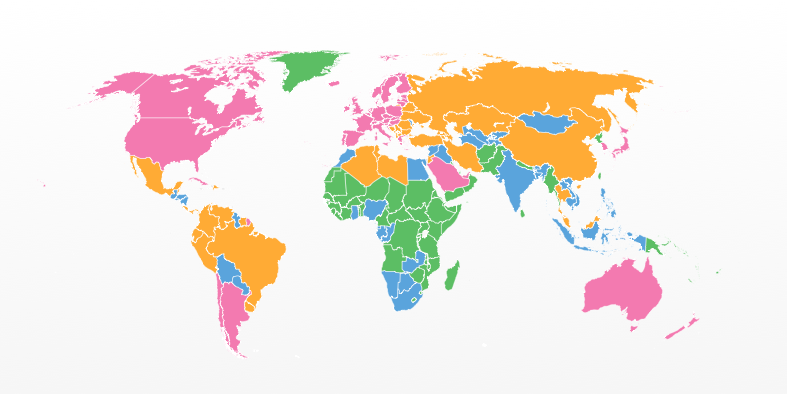Most mobile apps today use static pricing – every user sees and pays the same price for the content or subscriptions that the mobile app sells. In contrast, segmented pricing allows mobile app publishers to tailor prices of in-app content or subscriptions to specific user groups. This method of targeted pricing can increase app revenue and engage price-sensitive users with the paid experience.
In this blog post we look at 5 use cases of Sweet Pricing Pro, a tool that helps mobile app publishers use segmented pricing.
Use Case 1: Segment by Country
It is obvious that users in advanced economies, such as the UK and US, can afford to spend more than users in developing economies, such as India and China. So segmenting users by country is an attractive way to engage a more global audience. And that can help boost mobile app revenue.
To some degree, you can already do this kind of segmentation with Google Play and iTunes Connect. In Google Developer Console, you can set individual prices for each country that you distribute your app in. However, iTunes Connect has less flexibility and restricts you to a small number of alternate price tiers.
Using the standard tools that Google and Apple provide can make it difficult to test prices and have more fine-grained control over your in-app purchases. Since there is a large amount of variation between mobile apps, it is important to optimize pricing for your specific audience.
If you use Sweet Pricing, you can provide the user’s country to the Android or iOS SDK. You can determine country from the user’s device, network or other data that you hold. That data will then become available on the Analytics tab and you can use it to test pricing models that target specific countries.
Use Case 2: Segment by Demographic
Segmenting your audience by demographic data can be extremely useful. A well-known example of this approach is Tinder, which offers lower prices for users under 28 years of age. Pricing by factors like age can be useful for certain types of mobile app, particularly for dating apps.
With Sweet Pricing, you can provide any number of custom attributes to our SDK. You can filter these attributes in analytical reports and you can use them in segmented pricing models.
It goes without saying that discriminatory pricing on protected characteristics is often unethical and/or illegal. In some jurisdictions, it is lawful to offer concessions based on age, but this varies between countries. In any case, you should seek legal advice before using protected characteristics in your pricing models.
Even if you do not use demographic data in your pricing models, you can still provide it to Sweet Pricing for analytical purposes. This can help you understand the relationship between demographic and revenue, which you can use to target your marketing campaigns.
Use Case 3: Segment by Engagement
Any freemium app has a large number of non-paying users. And it is often the case that your least engaged users are not making purchases in your mobile app. On the other hand, your most engaged users are probably your most profitable users. It can therefore make sense to split your audience into “engaged” and “unengaged” groups and tailor the prices to each of these groups. This approach can encourage (otherwise unmonetized) unengaged users to make a purchase, which can boost revenue.
Sweet Pricing has a concept called enriched attributes. These are dynamic user attributes that we calculate to better describe and differentiate users. Our ‘engagement’ attribute is a value between 0 and 100, where 0 represents your least engaged user and 100 represents your most engaged user. We calculate this value for all users and you do not need to provide any additional data to our SDK.
For example, if you want to segment out your least engaged users for pricing, you can create a segment with the rule “engagement < 20”. This segment will contain 20% of your audience with the lowest engagement values. You can heavily discount prices for this segment to encourage monetization.
Use Case 4: Segment New Users
Your mobile app will lose almost 60% of users in their first month. While retention is a problem that segmented pricing cannot solve, you should keep retention in mind when thinking about monetization.
A popular approach already used by many mobile games and apps is to offer substantial discounts to new users. Mobile games often offer discounts of 50-80% for starter bundles for the first 24-48 hours after install. This approach encourages new players to enjoy the paid experience, which can help with retention and monetization over the long term.
Sweet Pricing does not currently send metadata to your mobile app, but you can control promotional displays in your app using semantic product IDs. If you want to trigger a specific display in your app, for example, you can use a product ID similar to “ns.100coins#newuser” – your mobile app will need to understand the meaning of your semantic ID and behave accordingly.
Use Case 5: Segment by Acquisition Source
You might find that a user’s price sensitivity depends on the marketing channel that acquired the user. Users that arrive from highly engaging campaigns might be more ‘purchase ready’ than random installs from the App Store, for example. If your mobile app relies on user acquisition from a number of sources, you might consider segmenting your pricing by campaign, too.
Acquisition attribution is an extremely important part of app marketing. It is likely you already know where your users come from (individually, not aggregate) and you can provide this data to Sweet Pricing via our Android or iOS SDK.
From Sweet Pricing Analytics, you can explore the relationship between acquisition source and revenue. If you find that certain campaigns are producing a low conversion rate, you can use segmented pricing to target these users and lower your pricing.

